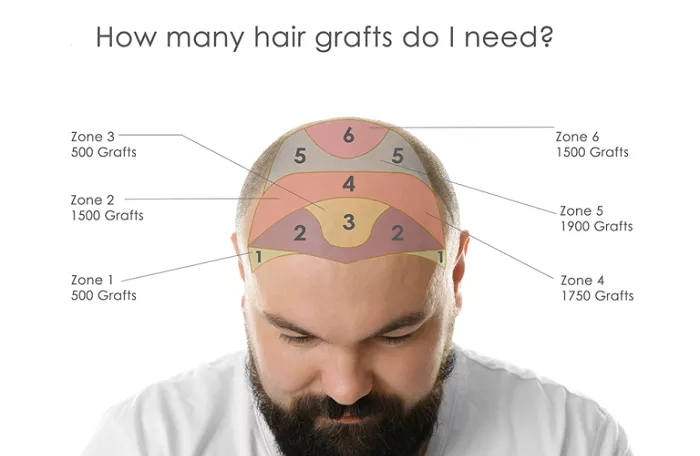Hair loss can be a distressing experience, affecting self-esteem and confidence. Hair transplant surgery offers a permanent solution by redistributing hair from denser areas to thinning or bald spots. Understanding how much hair you need for a successful transplant is crucial. This comprehensive guide will walk you through the factors determining the required hair grafts, ensuring you’re well-informed before making a decision.
What Is a Hair Transplant?
A hair transplant is a surgical procedure that moves hair follicles from a part of the body, known as the donor site, to a bald or balding part of the body, known as the recipient site. It’s primarily used to treat male pattern baldness but can also be effective for women experiencing hair thinning.
Types of Hair Transplant Techniques
Follicular Unit Transplantation (FUT): Involves removing a strip of scalp from the donor area and dissecting it into individual grafts.
Follicular Unit Extraction (FUE): Involves extracting individual hair follicles directly from the donor area and implanting them into the recipient area.
Both methods have their advantages and are chosen based on the patient’s needs and the surgeon’s recommendation.
Factors Determining the Number of Grafts Needed
1. Extent of Hair Loss
The severity of hair loss is a primary factor. The more extensive the bald area, the more grafts are required. Hair loss is commonly classified using the Norwood Scale for men and the Ludwig Scale for women.
2. Desired Hair Density
Some individuals prefer a fuller look, requiring more grafts, while others are satisfied with moderate coverage. Achieving a natural appearance is often possible with 50% of the original hair density.
3. Hair Characteristics
Hair texture, color, and curliness affect the visual density. For instance, curly or wavy hair provides better coverage than straight hair, potentially reducing the number of grafts needed.
4. Donor Area Availability
The donor area’s hair density and elasticity determine how many grafts can be safely harvested. Overharvesting can lead to noticeable thinning in the donor area.
Estimating Graft Requirements Based on Hair Loss Stages
The Norwood Scale provides a standardized way to assess male pattern baldness and estimate graft needs:
| Norwood Stage | Description | Estimated Grafts Needed |
|---|---|---|
| I | Minimal hair loss | 0 |
| II | Receding hairline | 500–1,500 |
| III | Deepening hairline recession | 1,500–2,000 |
| IV | Significant hairline and crown loss | 2,000–2,500 |
| V | Large areas of hair loss | 2,800–3,200 |
| VI | Extensive hair loss | 3,500–4,300 |
| VII | Severe hair loss | 5,000–6,000 |
It’s essential to consult with a hair transplant specialist to determine your specific needs accurately.
Graft Requirements by Scalp Area
Hairline
Restoring the hairline typically requires 800 to 1,500 grafts, depending on the desired shape and density.
Temples
Filling in the temples may need an additional 150 grafts per side.
Crown
The crown area, being larger, often requires between 800 to 1,500 grafts.
Full Scalp
For extensive hair loss covering the entire scalp, multiple sessions totaling 5,000 to 6,000 grafts may be necessary.
Donor Area Considerations
Assessing Donor Hair Availability
The average donor area can provide approximately 6,000 grafts. However, this varies based on individual hair density and scalp elasticity. An experienced surgeon will evaluate the donor area to ensure sufficient grafts can be harvested without compromising appearance.
Risks of Overharvesting
Extracting too many grafts can lead to noticeable thinning in the donor area. It’s crucial to balance the number of grafts taken with the donor area’s capacity to maintain a natural look.
Calculating Your Graft Needs
Step-by-Step Guide
1. Measure the Bald Area: Use a measuring tape to determine the length and width of the bald region in centimeters.
2. Calculate the Area: Multiply the length by the width to get the area in square centimeters.
3. Determine Desired Density: Decide on the number of grafts per square centimeter. A density of 30–40 grafts/cm² is often sufficient for a natural look.
4. Compute Total Grafts Needed: Multiply the area by the desired density.
Example:
- Area: 100 cm²
- Desired Density: 35 grafts/cm²
- Total Grafts Needed: 100 x 35 = 3,500 grafts
Maximizing Hair Transplant Success
Choosing the Right Surgeon
Select a board-certified surgeon with extensive experience in hair restoration. Review before-and-after photos of previous patients and read testimonials to assess their expertise.
Post-Operative Care
Follow your surgeon’s instructions carefully after the procedure. Proper care ensures optimal graft survival and promotes healthy hair growth.
Managing Expectations
Understand that hair growth is gradual. New hair typically starts to grow within 3–4 months, with full results visible after 9–12 months.
Conclusion
Determining how much hair you need for a transplant involves assessing the extent of hair loss, desired density, hair characteristics, and donor area availability. Consulting with a qualified hair transplant specialist is essential to develop a tailored plan that meets your expectations and ensures natural-looking results.
Remember, investing time in research and choosing the right professional can make a significant difference in your hair restoration journey.
Related topics:


